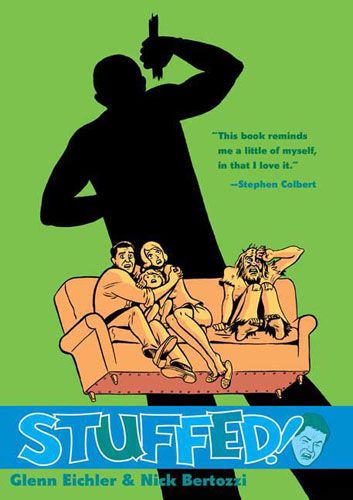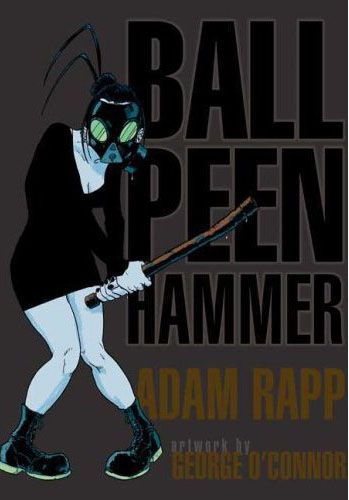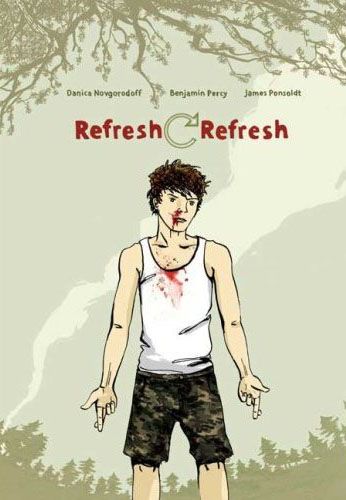by Glenn Eichler and Nick Bertozzi
First Second, 128 pages, $17.99.
By Adam Rapp and George O'Connor
First Second, 144 pages, $17.99
by Danica Novgorodoff, Benjamin Percy and James Ponsoldt
First Second, 144 pages, $17.99.
In addition to getting great Eurocomics into North American hands, one of the other -- perhaps more interesting, possibly odder -- feathers in First Second's cap is what I've opted to call (for lack of a better term) the match-up, wherein already penned screenplays or stories by professional prose writers are given to established cartoonists to translate into graphic novels. This fall saw the release of three books that fall into that category -- Stuffed!, Ball Peen Hammer and Refresh, Refresh. It's a process that, depending upon the quality of the original material and the talent of the artists involved, can go wildly in either direction between success and failure, a theory all three of these books seem to prove to one degree or another.
Stuffed! is about a staid, middle class white guy Tim Johnston who, upon the death of his father, inherits a decrepit museum of "oddities," which includes the disturbing statue of a supposed African warrior. What makes it even more disturbing is it's not actually a statue at all but a human corpse, preserved through the miracle of taxidermy (hence the title).
What follows is no doubt what Colbert Report writer Eicher and Salon author Bertozzi intended to be a madcap but warm and fuzzy look at race and human relations in 21st century America, as our hero attempts to donate the body to the Museum of Natural History, enlisting the help of an equally middle-class black professor there. Chaos interrupts in the form of Tim's clueless, aging, hippie half-brother who regards the warrior as a chance to salvage a quick couple of bucks or perhaps a last shred of dignity and respect.
And so it goes, with all the respectable leads trying to dance awkwardly around the question of what to do with the warrior, who, no doubt, represents our country's ugly history of institutionalized racism that so many of would prefer not to think about. The biggest problem with Stuffed!, however, is that everyone is just too darned nice. Even the hippie brother, clearly intended as a figure of fun and such an object of ridicule that he has an ugly little bump sticking out of his forehead from where he tried to drill a hole into his skull, comes off as a sympathetic character. To really have some bite to it, the book needs a villain -- someone who can vomit out all the hateful, obnoxious stuff that's going on thematically behind the plot. There's no one here for the cast to work against. Even Bertozzi, who has such a gift for caricature and flights of fancy, seems very staid and respectful here. This is a book where ugly truths are sidestepped rather than confronted, and it's a poorer book as a result.
On the other side of the room is Ball Peen Hammer which is a book filled with almost nothing but mean people. Downright savage in fact.
Hammer is another one of those post-apocalyptic showdowns that seem to be all the rage these days, set in a world where civilization has gone down the toilet and the surplus population seems to have rapidly decreased due to a nameless plague of some sort.
What's notable about the book, at least at first glance, is that it refuses to indulge in any potential grand guginol excesses. Except for a few minor exceptions, the book entirely takes place two rooms and features a cast of only about five or six people.
On the lower floor is Welton, a ailing musician and Aaron a writer. Both have recently joined a fringe, never named cult, ostensibly for protection, though the price for entry is horribly high. as the cult seems to believe in thinning the human ranks even further to get rid of any "undesirables." Above them are a young woman named Exley, who has important news for Welton, and a surly boy named Horlick, who stumble into each other by chance and form a quick bond.
All does not, however, go well. This is a bleak book, with lots of parallels about how the older generation feeds upon the younger one in a desperate attempt at short-term survival. Paper, no doubt, could be written, drawing comparisons between global warming's effects on future generations to what eventually happens to poor Horlick.
If Ball Peen Hammer succeeds at all, it's largely due to the work of artist O'Conner, who displays a deft, emotional touch that I hadn't seen in his previous book, Journey into Mowhawk Country. Neither photorealistic nor outright cartoony, his gangly characters manage to convey a ense of drama without coming off as stiff or forced.
Unfortunately, Hammer can't quite shake it's dramatic roots. I don't know for certain that Rapp originally wrote this for the theater, but it has a hard-to-describe staginess about it, especially in its dialogue and setting. It creates an artificial barrier that made it hard for me to fully invest myself in the tale.
I didn't have that problem with Refresh, Refresh, which had a lengthy route from short story to screenplay to graphic novel. The book is about a trio of teen-age boys, whose dads are all far away, soldiers fighting in the Iraq War. Refresh follows the youths as they attempt to grow up and figure out what direction their lives should take in a place where there are precious few examples to follow.
I didn't care much for Novgorodoff's previous book, Slow Storm, feeling that it spent so much time on atmosphere and character that it neglected to tell a compelling story. That's not the case here. Everything that was a weakness in Storm is a strength in Refresh. Working with the writers Percy and Ponsoldt's initial material, she does a fantastic job conveying the boys' restlessness and fear of what adulthood may bring. Novgorodoff seems to know rural America and it's culture very well (I believe she hails from Kentucky) and she fills her pages with elegant watercolors of identifiable tropes -- late night diners, trailer parks, big box stores and seemingly endless wilderness.
Like Hammer, Refresh has something to say about our culture's relationship between the old and young, and how we force the latter into choices they're not ready to make yet. I enjoyed Refresh more, perhaps because it deals more with the "real" world we currently live in though I like to think it has more to do with Novgorodoff's skill and the strength of the material (the ending, where Novgorodoff pulls back to show a series of blurry, minimalist images set in Iraq verges on an almost iconic poetry). If anything, it's suggestive that First Second's method of pairing up screenwriters and cartoonists does have merit and can produce good graphic novels.




